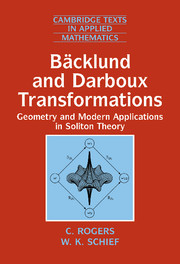Book contents
- Frontmatter
- Contents
- Preface
- Acknowledgements
- General Introduction and Outline
- 1 Pseudospherical Surfaces and the Classical Bäcklund Transformation. The Bianchi System
- 2 The Motion of Curves and Surfaces. Soliton Connections
- 3 Tzitzeica Surfaces. Conjugate Nets and the Toda Lattice Scheme
- 4 Hasimoto Surfaces and the Nonlinear Schrödinger Equation. Geometry and Associated Soliton Equations
- 5 Isothermic Surfaces. The Calapso and Zoomeron Equations
- 6 General Aspects of Soliton Surfaces. Role of Gauge and Reciprocal Transformations
- 7 Bäcklund Transformation and Darboux Matrix Connections
- 8 Bianchi and Ernst Systems. Bäcklund Transformations and Permutability Theorems
- 9 Projective-Minimal and Isothermal-Asymptotic Surfaces
- Appendix A The su(2)–so(3) Isomorphism
- Appendix B CC-Ideals
- Appendix C Biographies
- Bibliography and Author Index
- Subject Index
9 - Projective-Minimal and Isothermal-Asymptotic Surfaces
Published online by Cambridge University Press: 04 March 2010
- Frontmatter
- Contents
- Preface
- Acknowledgements
- General Introduction and Outline
- 1 Pseudospherical Surfaces and the Classical Bäcklund Transformation. The Bianchi System
- 2 The Motion of Curves and Surfaces. Soliton Connections
- 3 Tzitzeica Surfaces. Conjugate Nets and the Toda Lattice Scheme
- 4 Hasimoto Surfaces and the Nonlinear Schrödinger Equation. Geometry and Associated Soliton Equations
- 5 Isothermic Surfaces. The Calapso and Zoomeron Equations
- 6 General Aspects of Soliton Surfaces. Role of Gauge and Reciprocal Transformations
- 7 Bäcklund Transformation and Darboux Matrix Connections
- 8 Bianchi and Ernst Systems. Bäcklund Transformations and Permutability Theorems
- 9 Projective-Minimal and Isothermal-Asymptotic Surfaces
- Appendix A The su(2)–so(3) Isomorphism
- Appendix B CC-Ideals
- Appendix C Biographies
- Bibliography and Author Index
- Subject Index
Summary
The study of the projective differential geometry of surfaces has roots in the work of Wilczynski at the beginning of the last century. There have been a number of monographs on the subject, notably by Fubini and Ĉech, Bol, Finikov, Lane, Akivis and Goldberg. It has been established recently that privileged classes of surfaces in classical projective differential geometry are, in fact, described by integrable systems that pertain to modern soliton theory. A lucid summary of these connections and their historical origins have been given by Ferapontov. It will be with these integrable classes of surfaces of projective differential geometry that the present chapter will be concerned. The emphasis will be on projective-minimal and isothermal-asymptotic surfaces.
Projective-minimal surfaces arise out of the Euler-Lagrange equations associated with extremals of a projective area functional. These Euler-Lagrange equations were set down by Thomsen in 1928 and later taken up by Sasaki. Included in the class of projective-minimal surfaces are the surfaces of Godeaux-Rozet and those of Demoulin. The latter are governed by a coupled Tzitzeica system, which may be derived as a reduction of the two-dimensional Toda lattice system. Bäcklund transformations and associated permutability theorems for Godeaux-Rozet and Demoulin surfaces were derived in a purely geometric manner by Demoulin. It is remarked that projective-minimal and, in particular, Godeaux-Rozet and Demoulin surfaces arise in the theory of Lie quadrics.
- Type
- Chapter
- Information
- Bäcklund and Darboux TransformationsGeometry and Modern Applications in Soliton Theory, pp. 329 - 370Publisher: Cambridge University PressPrint publication year: 2002

